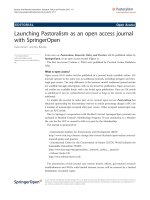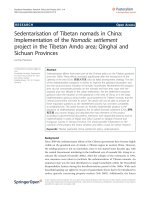Swift Pastoralism: Research, Policy and Practice 2011, 1:5 ppt
Bạn đang xem bản rút gọn của tài liệu. Xem và tải ngay bản đầy đủ của tài liệu tại đây (103.97 KB, 3 trang )
BOO K REV I E W Open Access
Katherine Homewood. Ecology of African Pastoralism
Jeremy J Swift
Correspondence:
recently retired from the Institute
of Development Studies, University
of Sussex, Brighton BN1 9RE, UK
Book details
Homewood Katherine: Ecology of African Pastoralist Societies. Oxford: James Currey; Athens:
Ohio University Press; Pretoria: Unisa Press; 2008:392 pages. ISBN 978-0-85255-990-1
Katharine Homewood has written a bold book of wide scope. Her objective is to b ring
together material on the ecology, in the broadest sense, of pastoral groups throughout
Africa. She wants to show the diversity of pastoral systems, the ways they intera ct with
other forms of land use, while analysing common character istics across pastoral socie-
ties as a whole. As Professor of Anthropology at University College London, a noted
researcher on the Maasai, and the promoter of an excellent Masters degree in Anthro-
pology which focuses on ecological issues, Homewood is well placed to do this.
She covers an enormous field. In nomadic fashion she roams widely across the pastoral
literature, covering pastoral groups in West Africa as well and Eastern and Southern
Africa; she reports findings from several disciplines, and from specialist fields. The ecologi-
cal focus of the book means that natural science and ecology occupy the most important
place, but there is a solid social and political scaffolding.
The book opens with a short summary of cross-cutting issues which underpin the
analysis of Africa n pastoral syste ms and provi de a framework within which we can
understand the trajectories of change in pastoral societies. Homewood’s underlying
idea is, first, to link dryland ecosystem dynamics to associated patterns of pastoralist
use (especially mobility); second, to explore how management of and access to these
resources interacts with the social, economic and political dimensions of pastoral
society; and third, t o present changes in resource tenure which in her view make it
necessary to rethink theories of development, livelihoods and diversification.
Chapter 2 covers the origins and spread of African pastoralism and the emergence of
present-day pastoralist societies. Chapter 3 describes the environments inhabited by
pastoralists, summarises the debate about equilibrium and non-equilibrium s ystems,
and describes pastoral tenure arrangements. This chapter concludes with a discussion
of pastoral production strategies. Chapter 4 then summarises the contemporary
pastoral systems in both dry and more humid areas of Africa.
Chapter 5 takes a more analytic look at pastoral livelihoods and econom ies. Chapter
6 describes herd biology and dynamics. Chapter 7 describes food systems, diets and
nutrition. Chapter 8, by Sara Randall in Homewood’s department at UCL, describes
the l ittle we know about pastoral demography, and concludes that co ntrary to what
some have argued, there isn’ t a single pastoral de mographic regime, but there are
Swift Pastoralism: Research, Policy and Practice 2011, 1:5
/>© 2011 Swift; licensee Springer. This is an Open Access article distributed under the terms of the Creative Commons Attribution
License ( ), which permits unrestricted use, distribution, and reproduction in any medium,
provided the original work is properly cited.
common themes; Chapter 9 draws conclusions abou t diversification, development and
change in pastoral livelihoods.
This is a wide ranging approach with many strengths. Highlights include a balanced
introduction to the equilibrium/ non-equilibrium ecosystems debate which concludes
that it involves not so much a disagreement about theory, as the result of different types
of empirical experience. Equilibrium systems, in which density-dependant factors are a
major in fluence on primary production (too many cows eat up all the grass an d prevent
pasture recov ery; herd size should be adjusted to the long -term carrying capacity of the
pasture they have available), occur in higher rainfall areas. Non-equilibrium systems,
where random external e vents suc h as drought are the main determinant of pasture
avail ability, are fo und in drier areas: as rainfall diminishes it becomes more variable an d
this variability becomes an increasing source of vulnerability. In such condition s the cal-
culation and use for management of a carrying capacity for any specific pasture is point-
less since the number of animals is not in itself a determinant of pasture growth. (The
number of cows is irrelevant to long-term past ure prosperity, since it the latter is deter-
mined b y events external to the ecosystem, not by density dependent factors.) This has
obvious implications for support to pastoralist strategies and for management.
Chapter 5 discusses pastoral livelihoods and economy from a starting point in mod-
elling. Here the empirical data are weak and it is hazardous to average them f rom a
small number of detailed models or cases. This is especially true of the discussion
about pastoral labour, the elephant i n the room in most analyses of pastoral develop-
ment. Pastoral labour has very different characteristics from agricultural labour (very
significant role played by individual skills and knowledge so that one hour’sinputby
person A is very different from an hour put in by person B; substantial economies of
scale in some operations with large step jumps in labour requirements between herd
size categories; wide seasonal differences in labour demand but year-round labour
inputs required; large differences in the skills required for different tasks), but we scar-
cely begin to understand pastoral labour so far.
Homewood’s description of the place of markets is uneasy. In her treatment, markets
play a quite small, walk-on, role, m ainly as part of the recent h istory of economic
diversification. This does not do justice to the central role played by markets in pas-
toral livelihoods f or a very long time, and the key role likely to be played by marke ts
in future pastoral development.
The m arketing discussion opens with the commercialisation of d airying. The main
discussion of marketing more generally is in a set of case histories from each geogra-
phical area, focussed on events since the 1960 s. There is little discussion of the growth
in marketing related to other aspects of pastoral economy and society, and especially
marketing as the engine for far-reaching changes in pa storal production; its impact on
ownership and control of production factors, on gender, the location of power,
livestock production itself including herd management strategies, poverty.
A key aspect of growth in marketing of livestock products is the terms of trade between
products pastoralists sell (especially live animals), and those they buy (especially staple cer-
eals, cloth and veterinary drugs). Over the long term secular changes in pastoral terms of
trade have had an important impact on pastoral livelihoods and pastoral welfare. Where
there have been im provements in terms of trade, it has been possible for ho useholds to
live from smaller herds, and such changes in terms of trade have stimulated changes in
Swift Pastoralism: Research, Policy and Practice 2011, 1:5
/>Page 2 of 3
the age and species composition of household herds. Neverth eless increased re liance on
livestock sales in a volatile market has made pastoralists more vulnerable.
The most serious impact of volatile terms of trade occurs in pastoral famines. Pastoral
famines are essentially a breakdown in terms of trade resulting from collapsing animal
prices and soaring ce real prices. These changes can be triggered by drought, but may
also be the consequence of other influences on price or availability of livestock or cereals
in the market. Perhaps the largest African famine-atthestartofthecolonialregimes
around the turn of the 20
th
century - was caused by rinderpest. Homewood mentions all
this in a couple of paragraphs, but it deserves a central place in her discussion.
Livelihood diversification is identified as a possible forward trajectory, but a depres-
sing table of diversification activities ranked b y wealth class shows that it is only
well-off and wealthy pastoralists who diversify into pro ductive activities. For poorer
pastoralists diversification means adoption of one or more from a range of coping
strategies which generally lock such households into long-term poverty.
Homewood has performed a long-overdue task by bringing together material scattered
over a large number of publications. The resulting study is enormously valuable because it
bring s together in one place info rmation which, if properly used, could make possible a
better understanding of pastoral livelihoods, and more enlightened development planning.
The book serves several audiences: undergraduates and other learners interested mainly
in pastoralism; specialists in related subject matters seeking to understand how pastoral-
ism impinges on their professional interests; civil servants in countries with nomad popu-
lations; elected members of national assemblies representing pastoralists; d evelopment
planners in government and agencies dealing with pastoral societie s; literate pastoralists
seeking to understand their own society and how it could move forwards.
The book provides an ex tremely good primer for these audiences. If copi es could be
got into governments and development agencies it would be a major step towards a
common platform of understanding of pastoral rationality, which is perhaps the most
important outcome that can be expected. An enlightened development agency could
have a significant impact on pastoral development by buying a hundred copies and
mailing t hem to key government people in countries with nomadic pastoral popula-
tions, and agency department heads.
A further task remains. It is now imperative to bring together all this empirical mate-
rial into a more theoretical model of pastoral livelihoods, a model with both explana-
tory and predictive power. Thanks to Homewood’s synthesis we now have many key
elements. We need a volunteer for this next task.
Author information
JJS retired recently from the Institute of Development Studies, University of Sussex. He has worked on pastoral
research and development in East and West Africa, the Middle East and Central Asia including China and Mongolia.
Competing interests
The authors declare that they have no competing interests.
Received: 8 March 2011 Accepted: 9 May 2011 Published: 9 May 2011
doi:10.1186/2041-7136-1-5
Cite this article as: Swift: Katherine Homewood. Ecology of African Pastoralism. Pastoralism: Research, Policy and Practice
2011 1:5.
Swift Pastoralism: Research, Policy and Practice 2011, 1:5
/>Page 3 of 3









